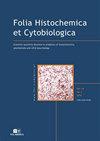Repeated isoflurane exposures of neonatal rats contribute to cognitive dysfunction in juvenile animals: the role of miR-497 in isoflurane-induced neurotoxicity.
IF 2.2
4区 生物学
Q4 BIOCHEMISTRY & MOLECULAR BIOLOGY
引用次数: 1
Abstract
INTRODUCTION Isoflurane anesthesia at the period of brain development can lead to neurotoxicity and long-term cognitive impairment. This study aimed to investigate the role of miR-497 on isoflurane-induced neurotoxicity. MATERIAL AND METHODS Neonatal rats (P7) were subject to isoflurane for 2 h at P7, P9, and P11. MiR-497 and neuron apoptosis were evaluated in hippocampal tissue by qRT-PCR and western blot. Fear conditioning test and Morris water maze were performed to determine cognitive function. The cell viability of isolated hippocampal neuronal cells exposed to isoflurane was measured using MTT test. The regulation of phospholipase D1 (PLD1) by miR-497 in isolated hippocampal neuronal cells was evaluated by luciferase reporter assays and western blot. Immunohistochemistry and TUNEL staining were employed to examine the PLD1 expression and neuronal cell apoptosis in hippocampus of neonatal rats, respectively. RESULTS Repeated isoflurane anesthesia led to neurons' apoptosis and long-term cognitive impairment. Isoflurane exposure led to apoptosis and viability reduction in hippocampal neuronal cells. MiR-497 was observed to be upregulated after isoflurane exposure both in vivo and in vitro. Knockdown of miR-497 attenuated isoflurane-induced neuronal cells apoptosis and viability reduction. Furthermore, PLD1 was predicted and then validated as a novel target of miR-497. miR-497 could negatively regulate PLD1 by binding to its 3'-untranslated region. Downregulation of PLD1 was also observed after isoflurane exposure in neonatal rat hippocampus and hippocampal primary neuronal cell cultures. CONCLUSIONS Induction of miR-497 was involved in isoflurane anesthesia-induced cognitive impairment and neuronal cell apoptosis by targeting PLD1. miR-497 may be a novel potential mechanism in isoflurane-induced neurotoxicity so that our findings provide new insight into a better and understanding of the clinical application of isoflurane.新生大鼠反复暴露于异氟醚有助于幼年动物的认知功能障碍:miR-497在异氟醚诱导的神经毒性中的作用
脑发育期间异氟醚麻醉可导致神经毒性和长期认知障碍。本研究旨在探讨miR-497在异氟醚诱导的神经毒性中的作用。材料与方法将新生大鼠(P7)在P7、P9、P11时经异氟醚处理2 h。采用qRT-PCR和western blot检测海马组织中MiR-497与神经元凋亡的关系。采用恐惧条件反射试验和Morris水迷宫测试认知功能。用MTT法测定异氟醚对分离海马神经元细胞的细胞活力。通过荧光素酶报告基因检测和western blot检测miR-497对离体海马神经元细胞磷脂酶D1 (PLD1)的调控作用。采用免疫组织化学和TUNEL染色分别检测新生大鼠海马组织PLD1表达和神经元细胞凋亡情况。结果反复异氟醚麻醉导致大鼠神经元凋亡和长期认知功能障碍。异氟醚暴露导致海马神经元细胞凋亡和活力降低。在体内和体外均观察到异氟烷暴露后MiR-497上调。miR-497敲低可减弱异氟醚诱导的神经元细胞凋亡和活力降低。此外,PLD1被预测并验证为miR-497的新靶点。miR-497可以通过结合PLD1的3'-非翻译区负性调节PLD1。异氟醚暴露在新生大鼠海马和海马原代神经元细胞培养后,也观察到PLD1的下调。结论miR-497通过靶向PLD1参与异氟醚麻醉诱导的认知功能障碍和神经元细胞凋亡。miR-497可能是异氟烷诱导神经毒性的一种新的潜在机制,因此我们的研究结果为更好地理解异氟烷的临床应用提供了新的见解。
本文章由计算机程序翻译,如有差异,请以英文原文为准。
求助全文
约1分钟内获得全文
求助全文
来源期刊

Folia histochemica et cytobiologica
生物-生化与分子生物学
CiteScore
2.80
自引率
6.70%
发文量
56
审稿时长
6-12 weeks
期刊介绍:
"Folia Histochemica et Cytobiologica" is an international, English-language journal publishing articles in the areas of histochemistry, cytochemistry and cell & tissue biology.
"Folia Histochemica et Cytobiologica" was established in 1963 under the title: ‘Folia Histochemica et Cytochemica’ by the Polish Histochemical and Cytochemical Society as a journal devoted to the rapidly developing fields of histochemistry and cytochemistry. In 1984, the profile of the journal was broadened to accommodate papers dealing with cell and tissue biology, and the title was accordingly changed to "Folia Histochemica et Cytobiologica".
"Folia Histochemica et Cytobiologica" is published quarterly, one volume a year, by the Polish Histochemical and Cytochemical Society.
 求助内容:
求助内容: 应助结果提醒方式:
应助结果提醒方式:


